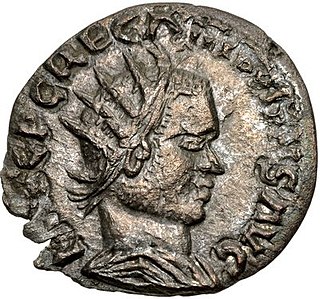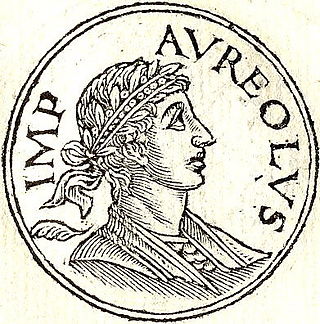3rd century Roman imperial usurper

Valens Thessalonicus was a Roman usurper during the reign of Emperor Gallienus.

Valens Thessalonicus was a Roman usurper during the reign of Emperor Gallienus.
In June 260, Persian king Shāpūr I defeated and took Emperor Valerian captive at Edessa in Roman Mesopotamia. Valerian's son, Gallienus who had ruled jointly with his father, immediately became the sole Roman emperor. Gallienus, however, ruled the western portion of the empire and was far away from the threats of the East. [1]
Without Valerian in the east, the border populations and their legions felt vulnerable and elected their own emperors to guarantee they would have leaders against foreign threats. After the capture of Valerian, the legions of Pannonia threw off their allegiance to Gallienus and proclaimed Ingenuus, their military commander, emperor. After Gallienus put down this rebellion and returned to Italy to deal with the Alemannic invasion, another Roman general in Pannonia, Regalianus, would attempt to take the throne. [2] [3]
Meanwhile, in Syria, Macrianus Major, one of Valerian's officers in charge of the treasury took advantage of the situation, gained the support of a key military commander, Balista, and claimed the throne for his two sons, Macrianus Minor and Quietus. In 261, after securing control of Egypt, Syria and Asia Minor, Macrianus Major and his son Macrianus Minor decided that they would travel west to Italy to confront and overthrow Gallienus. In their path to Italy, however, were the governors of the various Roman provinces with their military forces. One such governor remaining loyal to Emperor Gallienus was Valens Thessalonicus of the province of Achaea. [1]
To eliminate the threat of Valens and clear the track east, Macrianus Major and his son sent Piso to Achaea to kill Valens. [1]
Little, however, is actually known about Piso. The only source of information about Piso and his mission is the unreliable Historia Augusta. Piso is said to be a descendant of the gens Calpurnia and to have received the title Frugi for his severe virtues. [1]
The details of Piso's actions at the time are also unclear. Ultimately, Piso journeyed only as far as Thessaly where he pronounced himself emperor assuming the name "Thessalicus," most likely a confused reference to Valens Thessalonicus. Later that same year Piso's short revolt was ended when he was killed by Valens' troopers. [1]
Valens actions during this same period are also unclear. Sometime during 261 as Piso was on his way to kill him, Valens also claimed the Roman throne. It is not clear if this was done to enhance his standing as he confronted the threat from the east or if the title and position was imposed on him by his soldiers. Regardless, Valens' soldiers sought out and killed the usurper Piso and later assassinated him for reasons unknown. [1]
Macrianus Major and his son attempted to march their army to confront Gallienus, but were defeated in Thrace in 261 by Aureolus, Gallienus’ Imperial Horsemaster. Macrianus and his son were killed in the battle. According to Joannes Zonaras, their army was encircled by Aureolus and surrendered. [4] Macrianus asked to be killed with his son to avoid being taken captive. [1] [5]
Quietus who had remained Roman Mesopotamia was besieged in Emesa in 261 and killed by Odaenathus of Palmyra, a loyal client king of the Romans. [6]

Publius Licinius Egnatius Gallienus was Roman emperor with his father Valerian from 253 to 260 and alone from 260 to 268. He ruled during the Crisis of the Third Century that nearly caused the collapse of the empire. He won numerous military victories against usurpers and Germanic tribes, but was unable to prevent the secession of important provinces. His 15-year reign was the longest in half a century.
The 260s decade ran from January 1, 260, to December 31, 269.

Valerian was Roman emperor from 253 to spring 260 AD. Valerian is known as the first Roman emperor to have been taken captive in battle, captured by the Persian emperor Shapur I after the Battle of Edessa, causing shock and instability throughout the Roman Empire. The unprecedented event and the unknown fate of the captured emperor generated a variety of different reactions and "new narratives about the Roman Empire in diverse contexts".

The Gallic Empire or the Gallic Roman Empire are names used in modern historiography for a breakaway part of the Roman Empire that functioned de facto as a separate state from 260 to 274. It originated during the Crisis of the Third Century, when a series of Roman military leaders and aristocrats declared themselves emperors and took control of Gaul and adjacent provinces without attempting to conquer Italy or otherwise seize the central Roman administrative apparatus.

Marcus Cassianius Latinius Postumus was a Roman commander of Batavian origin, who ruled as emperor of the splinter state of the Roman Empire known to modern historians as the Gallic Empire. The Roman army in Gaul threw off its allegiance to Gallienus around the year 260, and Postumus assumed the title and powers of Emperor in the provinces of Gaul, Germania, Britannia, and Hispania. He ruled for the better part of ten years before he was murdered by his own troops.

Ingenuus was a Roman military commander, the imperial legate in Pannonia, who became a usurper to the throne of the emperor Gallienus when he led a brief and unsuccessful revolt in the year 260. Appointed by Gallienus himself, Ingenuus served him well by repulsing a Sarmatian invasion and securing the Pannonian border, at least temporarily. Ingenuus had also been charged with the military education of Caesar Cornelius Licinius Valerianus, the young son of Emperor Gallienus, but after the boy's death in 258, his position became perilous.

P. C. Regalianus, also known as Regalian, was Roman usurper for a few months in 260 and/or 261, during the Crisis of the Third Century, a period of intense political instability in the Roman Empire. Regalianus was acclaimed emperor by the troops along the Danube river, a region of the empire that frequently experienced barbarian raids, probably in the hope that he might be able to secure the frontier.

Fulvius Macrianus, also called Macrianus Major, was a Roman usurper. He was one of Valerian's fiscal officers. More precisely, sources refer to him as being in charge of the whole state accounts or, in the language of a later age, as Count of the Treasury and the person in charge of markets and provisions. It seems almost certain that he was an Equestrian. The Historia Augusta claims that he was the foremost of Valerian's military commanders, but that is most likely a gross exaggeration, if not entirely fictitious.

Titus Fulvius Iunius Macrianus, also known as Macrianus Minor, was a Roman usurper. He was the son of Fulvius Macrianus, also known as Macrianus Major.

Titus Fulvius Junius Quietus was a Roman usurper against Roman Emperor Gallienus.

Lucius Mussius AemilianussignoAegippius who held a number of military and civilian positions during the middle of the third century. He is best known as a Roman usurper during the reign of Gallienus.

Aureolus was a Roman military commander during the reign of Emperor Gallienus before he attempted to usurp the Roman Empire. After turning against Gallienus, Aureolus was killed during the political turmoil that surrounded the Emperor's assassination in a conspiracy orchestrated by his senior officers. Aureolus is known as one of the Thirty Tyrants and is referenced in ancient sources including the Historia Augusta, Zonaras' epitome and Zosimus' Historia Nova.
Balista or Ballista, also known in the sources with the name of "Callistus", was one of the Thirty Tyrants of the controversial Historia Augusta, and supported the rebellion of the Macriani against Emperor Gallienus.

Publius Licinius Cornelius Valerianus, also known as Valerian II, was the eldest son of Roman Emperor Gallienus and Augusta Cornelia Salonina who was of Greek origin and grandson of the Emperor Valerian who was of a noble and traditional senatorial family.

Trebellianus was a Roman usurper listed among the thirty tyrants in the Historia Augusta. Modern historians consider this figure a character invented by the author of Historia, whose traditional name was Trebellius Pollio.
The Gallienus usurpers were the usurpers who claimed imperial power during the reign of Gallienus. The existence of usurpers during the Crisis of the Third Century was very common, and the high number of usurpers fought by Gallienus is due to his long rule; fifteen years was a long reign by the standards of the 3rd century Roman Empire.

Lucius Calpurnius Piso Frugi was probably a Roman general whom the imperial pretender Macrianus Major sent to suppress the governor of Achaia, Valens Thessalonicus. His existence is attested only by the unreliable Historia Augusta, which labels Piso as one of several usurpers who plagued the reign of Emperor Gallienus. While some historians grudgingly regard Piso as a historical figure, many reported details of his life, including his usurpation, are dismissed as fabrications.

The Battle of Edessa took place between the armies of the Roman Empire under the command of Emperor Valerian and the Sasanian Empire under Shahanshah Shapur I, in Edessa in 260. The Roman army was defeated and captured in its entirety by the Iranian forces; for the first time, a Roman emperor was taken prisoner.

{{cite book}}: CS1 maint: location missing publisher (link)